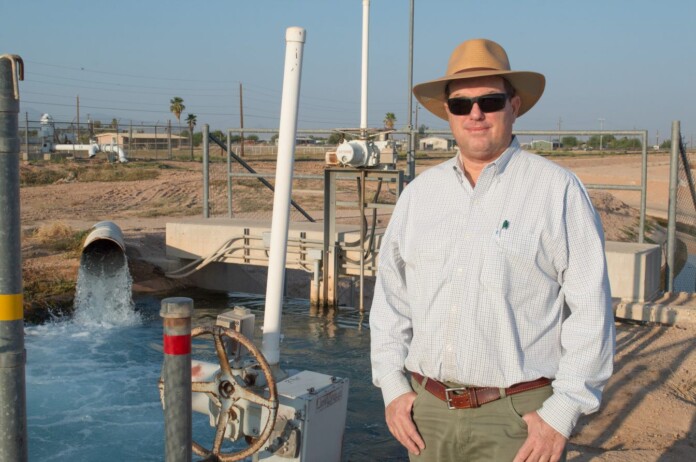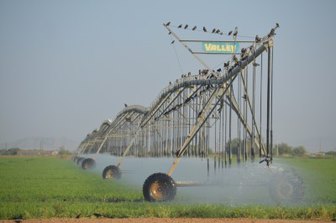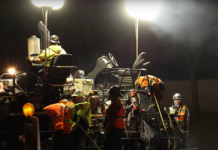
When the well is dry, we know the worth of water. –Benjamin Franklin
The U.S. Bureau of Reclamation declared in August the first-ever emergency water shortage in the Colorado River Basin — with mandatory consumption cuts beginning in 2022 — and farmers in Arizona will take the first hit.
It looks particularly bad for farmers in Pinal County.
The decades-long, climate change-fueled drought in the West has led water levels in key reservoirs to record lows. At 35% full, Lake Mead is at its lowest level since 1936, when the Hoover Dam was completed, and the lake filled. Mead is part of a system that provides water to about 40 million people.
Certain states will see reductions in how much water they get from the river, with Arizona set to lose nearly 20% of its supply next year. With about 70% of the river supply going to agriculture, it’s likely farmers will eventually see big reductions across millions of acres of land.
In 2023, it’s likely Colorado River water will dry up completely for county farmers, according to a June briefing by Central Arizona Project, known as CAP.
“Agriculture in central Arizona takes the first hit on these cutbacks,” said Chris Udall, executive director of the Agribusiness & Water Council of Arizona, who described a difficult future ahead for farmers in the state.
“It’s not a pretty picture, but it’s been understood and planned for over many years,” he said. “We’ll see reductions in water delivery to agriculture, and it’s a big chunk. It’s not a good number for them and a lot of growers are going to have to be cutting back.”
Many farmers — including some in and around Maricopa — rely on water from the CAP to irrigate their crops.
CAP is a series of canals built over 20 years beginning in 1973 to deliver water from the Colorado River to metropolitan Phoenix and Tucson. The federal government paid for most of the $4 billion project to moves 456 billion gallons of water annually. Central and southern Arizona suddenly had a seemingly endless supply of water.
But in exchange for that new source of water, some Arizona farming centers, including Pinal, accepted low priority among the Colorado River Basin states when it came to potential cutbacks. The basin is divided into two segments — the Upper Basin (Utah, Colorado, Wyoming and New Mexico) and the Lower Basin (Arizona, California, Nevada and Mexico).
With significantly less water delivered by CAP next year, local farmers could be forced to fallow many of their fields.
Udall said at least one farmer has told him he might have to cut his active acreage by 50%.
Bryan Hartman, whose family has farmed in Stanfield since the 1930s, grows alfalfa, corn, cotton, sorghum and oats. He said he will likely have to fallow 25-30% of his 2,000 acres.
“There will be some of us that survive and some of us who won’t,” he said.
THE HARD LESSON
Local farmers have only two sources of water: surface water (from CAP) and groundwater, which is pumped from the aquifer beneath the ground.
Hartman’s farm, like most in the area, used to get most of its water from CAP, but over the years that has dropped to about a 50-50 split. With the emergency declaration, that is about to change dramatically.
Hartman, who is president of the Maricopa-Stanfield Irrigation and Drainage District, uses about 4 feet of water per acre for a total of 8,000 acre-feet per year. An acre-foot is 325,851 gallons, enough to meet the water needs of three residential homes for a year. Put another way, Hartman’s farm uses as much water annually as 24,000 homes.
At about $60 per acre-foot for CAP water and about $45 per acre-foot for groundwater, Hartman spends about $420,000 a year to irrigate his crops.

“That means a lot more fallowed land,” Hartman said. “It’s about the same percentage of fallowed acres as the percentage of water we’ll lose. But it will be different for individual farms. Some have good well systems that can supplement the CAP water and some farms do not. It was this way before CAP and, unfortunately, now we’re going back.
“The CAP was great; it supplemented us, it brought up the water table, it was a godsend,” he added. “And now we’re going back.”
The crisis point for CAP customers in Arizona was reached over the past two springs. April-July runoff in the Upper Basin was just 26% of average this year, despite near-average snowfall, and in April-July 2020, runoff was just 52% of average. This triggered the shortage declaration and demonstrated the severity of the effects of 20-plus years of drought.
About 95% of the land in nine Western states is in some level of drought, with 64% in extreme drought or worse. It continues a 22-year megadrought that some experts believe may be the region’s worst dry spell in 1,200 years. The beginning of that drought, 1999, was the last time Lake Mead was at capacity.
“Basically every drop in the river is being utilized. And so everyone wants a piece of this river and there’s nothing left over,” Brad Udall, a climate scientist at Colorado State University, told KUNC-TV in an interview. “The hard lesson we’re learning about climate change is that it’s not a gradual, slow descent to a new state of affairs.”
Hartman isn’t too optimistic about ever seeing CAP water allocations again.
“There’s always the hope,” he said. “If the Upper Basin states get a huge year, yes, we could see something. Two or three years ago this happened; Lake Mead was dropping and the Bureau of Reclamation told us to get ready for a Tier 1 shortage and we had a miracle year of snowstorms and got our allocations.”
GOOD TO GROW
As dire the situation for farmers in the Maricopa area, the situation is far more secure for residents, city planners, developers and industry.
Global Water provides municipal and industrial water from groundwater in the Maricopa Stanfield sub-basin of the Pinal Active Management Area.
In fact, the aquifer — a body of porous rock or sediment saturated with groundwater — under Pinal County is “absolutely enormous,” according to Jake Lenderking, Global Water’s vice president of water resources and legislative affairs.
“The state does groundwater modeling for the assured water supply program,” he said. “In the greater Maricopa-Stanfield sub-basin, we have an almost limitless supply.”
A 2020 Pinal Active Management Area (AMA) Water Report prepared by the University of Arizona Water Resources Research Center, indicated abundant groundwater, with much of it stored in the aquifer for thousands of years.
As more ranches and farms in Maricopa are sold and converted to residential developments, that already-promising situation for non-farmers gets even better.
“We’ve been retiring agricultural land, which is a big water user, and putting in houses, which use far less water than farms do, which will stretch the supply even further,” he said.
Lenderking said the aquifer is only projected to drop by 100-200 feet over the next 100 years.
“Other areas are projected to go down 600-700 feet,” he said. “Maricopa is located in a good part of the aquifer. The state only models to 3,000 feet below the surface of the ground. In Maricopa, the depth of bedrock exceeds 6,400 feet below the surface, so we have 3,000-plus feet of water beyond what the state has even modeled.”
In addition to being incredibly deep, the aquifer is also quite close to the surface. Lenderking said in one area of Maricopa the water level is just 65 feet below the surface, making it easier and less expensive for some farmers to pump water.
Developers and municipalities are required to show proof of an assured 100-year water supply to build. That means all the houses in the city — and those approved for future development — have that assured water supply.
The city is using nowhere near the amount of water to which it currently has rights, according to City Manager Rick Horst. Its allocation of 23,000 acre-feet per year is more than three times actual usage of about 7,000 acre-feet.
That means ample water for those who live here and the hordes who will someday. As many as 8,000 acres will be developed over the coming decade, bringing perhaps 30,000 homes and more than 75,000 additional residents.
Tom Buschatske, director of the Arizona Department of Water Resources, confirmed development in Maricopa will not be impacted by the drought, at least not yet.
“There’s room for Maricopa and that area to keep growing, and what’s happening on the Colorado River isn’t going to impact the availability of water for that growth,” he said. “It won’t affect their assured water supply.”
NO EASY SOLUTION
“Agricultural users are a different story because they are lower-priority users,” Buschatske added, noting farmers have told his agency they might have to fallow 30%-40% of their land.
Before CAP water became available, farmers pumped more groundwater than the amount that was recharged, shrinking available supplies. The over-pumping resulted in some farmers having to dig deeper wells, land subsidence and earth fissures. Artificial recharge with renewable water or non-groundwater sources has helped rebalance the AMA’s groundwater situation.
With CAP water available, it became a bottom-line choice for farmers on how to irrigate their fields.
CAP water costs more, but Hartman said it is far easier to move around the district than pumped water, which has to be moved through a pipeline or a lateral canal. And then there is the issue of getting to the groundwater.
“Not all farms have as much groundwater, or good access to it,” Hartman said. “The water table could be 500 feet below the surface at one farm and 60 feet down at another. If it’s 500 feet down, with the pumping costs, it would be cheaper to use CAP water than to pump your own.”
But now Pinal County agriculture may have to return to a reliance on groundwater.
“We really have no choice but to pump now,” he said. “In ’22, we’ll have the mitigation water, the 30,000 acre-feet, but in ‘23 we’ll have nothing.”
And so, for now, Pinal farmers will bear the brunt of climate change and its diminishing effect on the water supply. Their farms will become less profitable as they produce fewer crops and incur costs to pump groundwater.
Hartman knows the next few years will be tough, but he’s cautiously optimistic.
“It’s going to be hard on all those landowners and growers for the next couple of years until they get acclimated back to just using groundwater,” he said. “I know we can do it. We did it for 50 years before the CAP came along and we know a lot more now about how to manage the water in our fields.
“We’ll be alright.”
This story was first published in the October edition of InMaricopa magazine.

![Shred-A-Thon to take place tomorrow An image of shredded paper. [Pixabay]](https://www.inmaricopa.com/wp-content/uploads/2024/03/shredded-paper-168650_1280-218x150.jpg)






![Elena Trails releases home renderings An image of one of 56 elevation renderings submitted to Maricopa's planning department for the Elena Trails subdivison. The developer plans to construct 14 different floor plans, with four elevation styles per plan. [City of Maricopa]](https://www.inmaricopa.com/wp-content/uploads/2024/04/city-041724-elena-trails-rendering-218x150.jpg)





![Shred-A-Thon to take place tomorrow An image of shredded paper. [Pixabay]](https://www.inmaricopa.com/wp-content/uploads/2024/03/shredded-paper-168650_1280-100x70.jpg)


